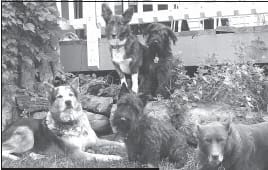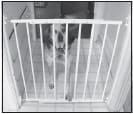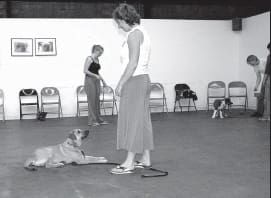More than 30 years ago, I had an “only dog.” Marty was a tricolor Collie – the first dog I owned as an adult. We were inseparable. I had the good fortune to work at a stable where Marty could accompany me every day. I took him to obedience classes and started showing in AKC competitions, where my furry boy was a star – earning his Companion Dog degree in three shows with scores of 194, 195.5, and 196 out of a possible perfect score of 200 points. Then I entered into my first serious adult relationship, with a man who had a St. Bernard/Collie mix. The two dogs quickly became fast friends, and we soon added an Irish Setter pup to our pack and I learned how to manage a multi-dog household.
Since that time I’ve had as many as five, never fewer than two, and usually at least three or four dogs sharing my home and life. It’s hard for me to even imagine having only one canine companion in our home. I’m a confirmed multi-dog person.

But not everyone finds it easy to adjust to having more than just one canine companion in the house – and the bed, the car, the vet’s office, and so on! There are definitely things to consider before adding a second dog (or more) to your “pack,” and ways to make living in a multi-dog household more manageable.
Things to consider
When asked whether it’s a good idea to add a second dog to a family, my answer is always an unequivocal “It depends!” If you’re adding a second dog for the right reasons and your first dog gets along with others, it may be a fine idea. Here are some things to consider when you’re thinking of adding a second, third, fourth (or more) dog to your pack:
- Are you getting the dog because you really want another? Despite the charming concept of “getting a dog for your dog,” you really should get another dog only for yourself. Getting a second dog isn’t likely to fix your first dog’s behavior problems, and may compound them. Besides, if you’re just getting a second as a companion for your first, you may not be as committed to keeping him if problems arise. And that’s not fair to dog number two!
- Are you ready for changes in your relationship with dog number one? Not that you’ll love her any less, but every time you add another dog it decreases the amount of one-on-one time you have to share with each. That inevitably changes the relationship to a greater or lesser degree, depending on the dogs, and depending on you. With five dogs in our home currently, it’s impossible for me to have the same relationship with each of them that I had with Marty 30-plus years ago. That doesn’t necessarily mean better or worse – just different.
- Does your dog enjoy, or at least tolerate, the company of other dogs? If not, you’re in for a serious challenge if you bring another canine into your life. I have clients who have resigned themselves to years of future management because one of their dogs is willing and able to do serious damage to their other(s). In some cases they knew this in advance and wanted the second dog anyway. In others, they found out after the new dog came home that the first dog had no wish to share his home.If you don’t know how your dog will be with another, you might borrow one from a friend for a week or two and see how it goes, before making a lifetime commitment to another canine.
- Do you have the resources to properly care for another dog? Not just money – which is certainly a consideration – but time, energy, willingness, and space? One more dog doesn’t seem like much at the time, but sometimes the stars align to throw you several curve balls at once.This happened to us recently. Our most geriatric pack member (Tucker) was diagnosed with prostate cancer, and shortly afterward, our Corgi, Lucy, took an unwise leap off a stone wall and seriously injured two of her legs. This has added up to thousands of dollars in vet bills, as well as numerous three-hour (round trip) visits to cancer and orthopedic specialists. And this isn’t even counting all the annual well-pet checks that total several hundred dollars.
- Are you being pressured? A friend or family member has to rehome their dog and is begging you to take him. You feel bad about leaving your dog home alone while you’re at work all day. Your kids are pestering you for a new puppy. A shelter or rescue group has contacted you about a dog who faces euthanasia if you don’t take her.Only let yourself be pressured into adopting another dog if all the other factors are right: you really want another dog, and it’s the right thing to do for all your family members and circumstances. When you do decide that another dog is in the cards, make a wise choice. It’s important to evaluate your own dog’s tem-perament and select a new family member who’s a good match for her personality as well as your own. This will make the transition much less stressful – and ultimately much more successful – for all concerned.
When the deed is done
Congratulations! As the proud owner of two or more dogs, you’re an official member of the “Multi-Dog Household” Club. You now have a pack to manage.
Pack management is as much an art as a skill. If you’ve always had multiple dogs, never had problems, and never thought twice about it, then good for you! You are one of the lucky ones – a natural. You’ve probably instinctively done all the right things to help your pack be well-adjusted. Many dog owners aren’t so fortunate.
Pack problems run the continuum from simple delinquent behaviors and poor manners to serious intra-pack aggression. While many owners tolerate the former, group bad manners can be the precursor to aggression. This is far more easily addressed before scuffles escalate to bloodletting. The basic tenet for a successful multi-dog household is simple: The more dogs in the home, the more “in charge” the human pack member(s) must be.
By the way, this does not mean you need to be demanding, forceful, or “dominant” in any way. You don’t need to eat first, go through doors first, roll your dogs on the ground, or any of the other ridiculous exercises that get carried out in the name of “dog training.”
A good leader doesn’t need to be violent; she simply needs to create an environment where it is easy and rewarding for her followers to comply with her wishes, and difficult for them to make mistakes. A successful leader/owner also controls valuable resources, and shares them with her dogs generously and judiciously. Appropriate behaviors earn rewards. Inappropriate behaviors do not. If resources are consistently awarded on the basis of desirable behaviors, and withheld in the presence of undesirable behaviors, desirable behaviors will increase, and the undesirable ones will slowly disappear. (See “Be a Benevolent Leader,” WDJ August 2003, for more information about leading your pack.)
The basic “in charge” tenet for pack management is closely followed by this corollary: The more dogs in your household, the better-trained and better-behaved the canine members of your pack must be.
If you have more than one dog, you’ll want to take each one through a complete, positive good manners training program, working with each dog individually. As they learn their lessons, train in twos, threes, and more, until they respond reliably to your cues in the presence of all pack members.
The other key to peaceful pack life is management. If you put good management programs in place early, you can sidestep potential pack problems. If you’re already facing pack behavior challenges, start by identifying the key areas of conflict, so you can figure out how to put a management plan in place to keep peace in the pack while you work on long-term training and modification solutions. Modification of serious intra-pack behaviors will probably require the assistance of a qualified, positive dog behavior professional.
Some of the skills and tools you’ll need for pack-management success include:
- Baby gates. Gates are a super-valuable tool for managing housetraining (keeping pups and young dogs in areas where they can’t ruin a rug if they have an “accident”), puppy teething (ditto), doggie dinnertime (especially if meals are a guarding trigger for your dog), and for keeping dogs separate (if necessary) during the social adjustment period after you bring your new dog home. (For more information on choosing and using gates in your home, see “A Gated Community,” July 2002.)

200
- Crates. Bedtime can be a perilous time when your dog feels he has to compete for the comfiest sleeping spot closest to you. Having the dogs sleep in your room, but in appropriately sized, well-cushioned crates, complete with a food-stuffed Kong or other appropriate chew toys, can help you keep the peace – and a piece of the mattress real estate! (See “Crate Difficulties,” May 2005, for more information on introducing your dog to sleeping in a crate.)
- An elaborately managed feeding time. Properly planned and executed, mealtimes can be an ideal place to work on your dog’s (or dogs’) good manners and self-control; deference to you, the “pack” leader; and modifying resource-guarding behavior. The expectation is that each dog waits quietly (sitting, ideally) in his regular supper spot for you to prepare and serve his food, finishes it without guarding it from others, and is dismissed from the area without trying to eat anyone else’s meal. Again, routine and structure are your allies here. (See “The Bowl Game,” July 2005, for detailed information on teaching your dog/s good manners at mealtime.)
- Knowledge about stress signals. Contrary to what the newspaper headlines often say, dogs rarely “attack without warning.” Experienced observers of canine body language can identify dozens of ways that dogs will telegraph their fear, anxiety, or discomfort with other dogs (or people).When you’ve added a new dog to your household, be alert to physical cues such as diminished appetite, gastrointestinal distress, decreased responsiveness to training cues, intolerance to being handled or groomed, or any displays of aggression, including “whale eye,” showing teeth, growling, snapping, or increased resource-guarding behavior. These may be indicators that your dog is stressed and feeling backed into a corner.Before your dog “loses it” and bites somebody, take appropriate steps now to defuse the situation, and give your stressed dog a little more physical space or a break from whatever is bothering him. (See “Stress Signals,” June 2006, for more information about recognizing signs of stress in your dog.)
- Knowledge about resource-guarding. It’s common for dogs to defend their food from other dogs, but edible items are not the only things that dogs will keep from all potential rivals. Some dogs will defend their “ownership” of toys, a favored place to sleep, or the water bowl. Behaviorists and dog trainers call these protective behaviors “resource-guarding.”A dog who defends his food from other dogs is exhibiting a perfectly normal and appropriate canine behavior. Resource-guarding is far less acceptable, of course, whenever it’s directed toward us, or when the dog starts World War III over any of his coveted possessions. For our own safety, we want dogs to understand that everything they have is really ours, to use ourselves or to parcel out to whatever dog we choose.Fortunately, mild resource-guarding behavior can be managed, and dogs can be desensitized to the presence of other dogs or people around his food bowl. (A thorough description of how to accomplish this can be seen in “Thanks for Sharing,” September 2001.) If your dog exhibits severe resource-guarding, you would be wise to consult a qualified, positive dog behavior professional.
Putting it all into practice
Here’s a description of how my husband and I live with our current five-pack, using all the tools and principles of positive training and management described above. The cast of characters includes:
• Katie, a 14-year-old, 45-pound, Aus-tralian Kelpie with arthritis and hearing loss. A typical herding dog control-freak, Katie cheer-leads when Lucy and Bonnie play, lifts lip, snarls, sometimes snaps when others invade her space. She has high-ranking aspirations, but is not an “alpha.”
• Tucker, a 13-year-old, 70-pound, Cattle Dog-mix with arthritis and prostate cancer. Tucker is our gentle, benevolent alpha. He sometimes plays fun-police role when the youngsters roughhouse indoors.
• Dubhy, a 6-year-old, 25-pound, Scottish Terrier. He’s quite a tough little guy, and tends to keep to himself. Dubhy is dog-reactive with dogs outside our pack. He will resource-guard things from his packmates; he took a pea-sized notch out of Katie’s ear several years ago, but there has been no blood spilled since.
• Lucy, a 2-year-old Cardigan Welsh Corgi. Definitely an alpha-wannabe, Lucy tries to control everything and everyone in the pack. She acknowledges Tucker’s higher status, but frequently challenges Katie. She also tries to control everyone’s movement, and does serious resource-guarding from the other pack members for food, toys, and space. She’s strong-willed, yet very sensitive to sounds and body language, exhibits distress when separated from us, and has lots of fear issues. She’s still recovering from her wall-jumping episode last winter, and limps slightly.
• Bonnie, a 1-year-old Scottie/Corgi mix. Bonnie has a super “soft” personality, and is perfectly content to let others be in charge. She’s the lowest-ranking member in the group, and a submissive urinator with other dogs and humans. She will resource-guard valuable objects from the other dogs with body blocking, not with aggression.
All the Miller dogs are moderately to very well trained. All can be off leash outdoors except Dubhy, whose outdoor recall is only about 50 percent reliable. A day in the Miller pack looks like this:
5:30 am: Alarm goes off. All dogs sleep in our bedroom, upstairs, with us. Lucy, who is prone to chasing cats and snarking with Katie over desirable space, is crated, as is Dubhy, who sometimes urine-marks in the house. Katie and Tucker sleep on magnetic beds (for their arthritis) on the floor; Bonnie sleeps on the bed or on the floor, whichever she prefers. Baby gates at the bottom of the stairs restrict Bonnie (and the rest) from total house freedom, as she still occasionally chews an inappropriate object, and once in a very great while has a housetraining accident. Paul dresses and heads to the barn to feed the horses.
6:00 am: I follow to the barn with the dogs. Going downstairs can be exciting, as Lucy and Katie want to battle over who gets to be first. It’s hard to converse with Katie due to her hearing loss, so I focus on Lucy, reinforcing her attention to me, and having her wait while Katie makes her way downstairs. Lucy, Bonnie, and I follow (Bonnie also very focused on Lucy’s reinforcers). Tucker and Dubhy, neither of whom feels any urgent need to be first, bring up the rear to the back door.
At the back door I put leashes on Lucy and Dubhy – the latter because his recall outdoors isn’t great and he’s easily lured away by resident groundhogs; Lucy to avoid Katie-snarking at the back door, and because her body-language and fear issues sometimes trigger her to avoid the barn.
The three younger dogs “Sit” and “Wait” at the back door in order to get the door to open. The older dogs, out of respect for their arthritic joints, aren’t asked to sit, but are expected to wait. Sometimes I give a general release and we all exit together; sometimes I use the door as an opportunity to practice individual releases.
Tucker, who was well-schooled in “Wait” as a youngster, and took his lessons to heart, is last again, as he waits for a personal invitation to pass through any doorway beyond our normal living area. So much for the high-ranking member always going first!
6:00 – 7:00 am: This is a significant piece of the exercise portion of our pack management program. While we feed horses and clean stalls, the dogs race up and down the barn aisle and chase each other madly around the indoor arena. Lucy and Bonnie, the youngest and wildest, run the hardest, with geriatric Katie cheerleading along behind. Dubhy rarely engages, preferring to observe. Tucker, with his delicious sense of humor, occasionally grabs Lucy’s toy to remind her that he can, then soon gives it back to her, laughing at her temper tantrum.

288
7:00 – 8:00 am: Breakfast time for the pack, and an important management/training opportunity in a multi-dog household. I gather up bowls and set them on the floor by the feed bin, then broadcast a handful of kibble across the kitchen floor for the young dogs so they can scavenge while I scoop food into bowls. Interestingly, all three of the young dogs resource-guard to some degree, yet share this task without any squabbling over kibble. They would sit and watch quietly while I scoop; this is just a fun activity.
Bowls then go on the counter for add-ins: chicken, canned food, glucosamine for joint health, Omega-3 and -6 fatty acids for coat and skin, a daily vitamin, and various medicines for all their various aliments and conditions. Dogs sit quietly at my feet during preparation. When the food is ready, they’re fed in their specific locations:
• Katie first, on the far side of the dining room. She gets hers first to prevent her from herding Tucker as he walks toward his bowl.
• Tucker next, on the near side of the dining room. He gets the most food, and since being diagnosed with cancer his appetite has diminished. He needs the most time to eat, and sometimes needs encouragement.
• Lucy, by the kitchen counter. She’s an eager eater, and must sit-and-wait until released when I put her bowl down, part of a good “say please” program, to remind her that I control the good stuff.
• Bonnie, about six feet from Lucy, under the kitchen clock. Bonnie also is required to sit-and-wait for her meal.
• Finally Dubhy, across from Bonnie next to the refrigerator. Dubhy enjoys mealtimes, and does an endearing little Scottie dance on the way to his meal spot. He, too, gets to sit-and-wait until released.
I watch as the dogs finish their meals. Tucker, who once protected his bowl without assistance, is less concerned about his food now. As the others finish, I call them to me and reinforce them for good manners behaviors so they don’t pester him.
Despite having several dogs willing to resource-guard from each other, our mealtimes are happily nonviolent. Lucy even allows Bonnie to help lick her bowl – probably because Bonnie is so low-ranking that Lucy perceives no threat from her. If we had “issues” over meals, we might put one or more dogs in separate rooms with doors closed, or in their crates, to manage mealtime aggression.
8:00 am – Noon: Everyone’s tired from the morning’s activities, and they all settle in for naps. Bonnie and Lucy crash in their crates in my office, Dubhy on a chair and Katie on a magnetic bed in the living room, Tucker sometimes in his favorite den: the nonworking fireplace in the dining room, sometimes on a bed in my office. Lucy used to fiercely resource-guard my office. Lots of counter-conditioning (other dogs in office make good stuff happen) has modified this behavior. I take time during this period (and/or the afternoon rest stop) to spend some one-on-one time with each dog – brushing, nail-trimming, a training session, or just cuddling.

288
Noon – 1:00 pm: Time for a potty break and some Frisbee action in the backyard. Sometimes Dubhy, Bonnie, and Katie play together in the yard for a while. Tucker and Lucy prefer being indoors.
1:00 – 5:00 pm: More quiet time in the house. Several times a week I’ll take the youngsters for a hike on the farm. Exercise does wonders for a peaceful pack. The two old-timers can’t handle the rigors of a farm hike; we do occasional gentle strolls around the fields.
Evenings: Dinner is much the same as breakfast. I feed dogs before we eat our dinner because A) the high-ranking members (hubby and me) don’t have to eat first; B) I don’t like to eat with hungry dogs staring at me; and C) once I eat dinner, I’m done for the night.
After dinner we all hang out in the living room, watching TV, working on the laptop, reading the newspaper, chewing on bones. This is the most likely time for pack conflict in our household.
If Bonnie and Lucy didn’t get enough exercise they’ll roughhouse, offending both Katie and Tucker. Katie, Lucy, Bonnie, and sometimes Dubhy may vie for prime space on the sofa, at my feet, or waiting for Paul to toss them some pretzel bits. Bonnie plays nicely with our two cats, but Lucy likes to chase them, and Katie wants to claim them as hers and guard them from the others.
I manage evening activities in various ways. Guarding behavior on or around the sofa earns timeouts for all players. I’ll take the two youngsters outside for extra play in the backyard if they need to burn off energy. Counter-conditioning has taught Lucy to look at me when a cat enters the room rather than give chase, and, with time, Katie has learned to share her kitties and now tolerates Bonnie’s gentle cat-play.
11:00 pm: Bedtime. I manage the trip upstairs, again reinforcing Lucy’s attention to me, to avoid stairway squabbles, and tuck everyone in until morning, when we get up and do it again. Amen.
Variations: Of course, I sometimes have other things to do besides play dog-referee. When I go to town to run errands, or walk out to the training center to teach, the pack usually stays home. This is raw-bone or chicken-wing time, and because our guarders will sometimes get uppity about high-value stuff, Bonnie gets hers in her crate (this is also a management step for her, as she’s not yet reliably housetrained), Lucy gets shut in my office with the crated Bonnie, and the other three compatibly share the rest of the house.
There are times when I reminisce about the simple days of just one or two dogs in my life. I may be tired in the evening and don’t feel like playing doorman for a pack of dogs. I’m sometimes tempted to yell at Lucy for her shrill barking. I have to remind myself that yelling doesn’t work, and that reinforcing desired behaviors is much more effective than losing my temper, and keeps me peaceful as well. Then I look at those five, wonderful furry faces, and know that I wouldn’t give any of them up for anything. It would be much too quiet with only one dog in our home.
Pat Miller, CPDT, is WDJ’s Training Editor. Miller lives in Hagerstown, Maryland, site of her Peaceable Paws training center.






